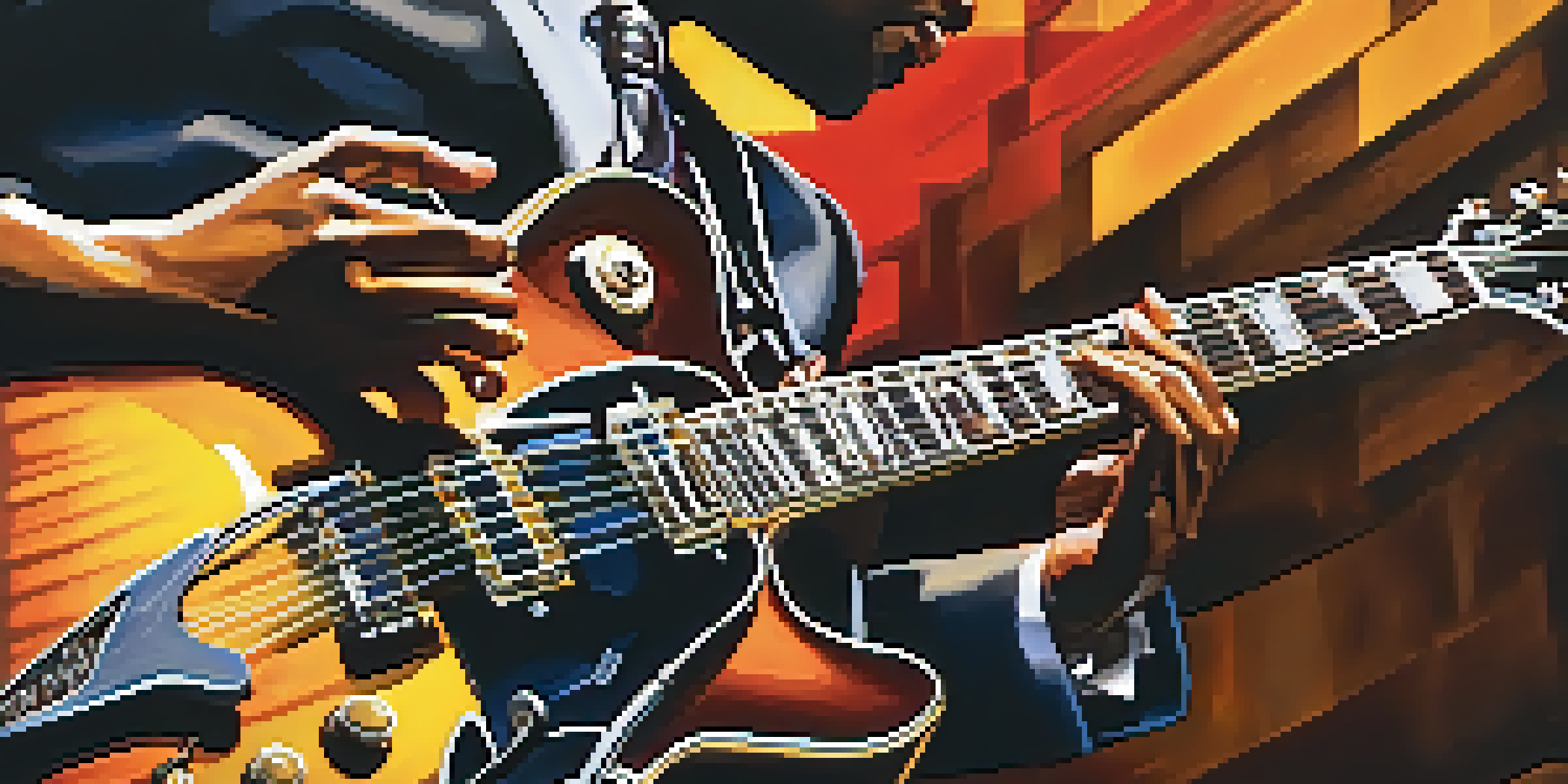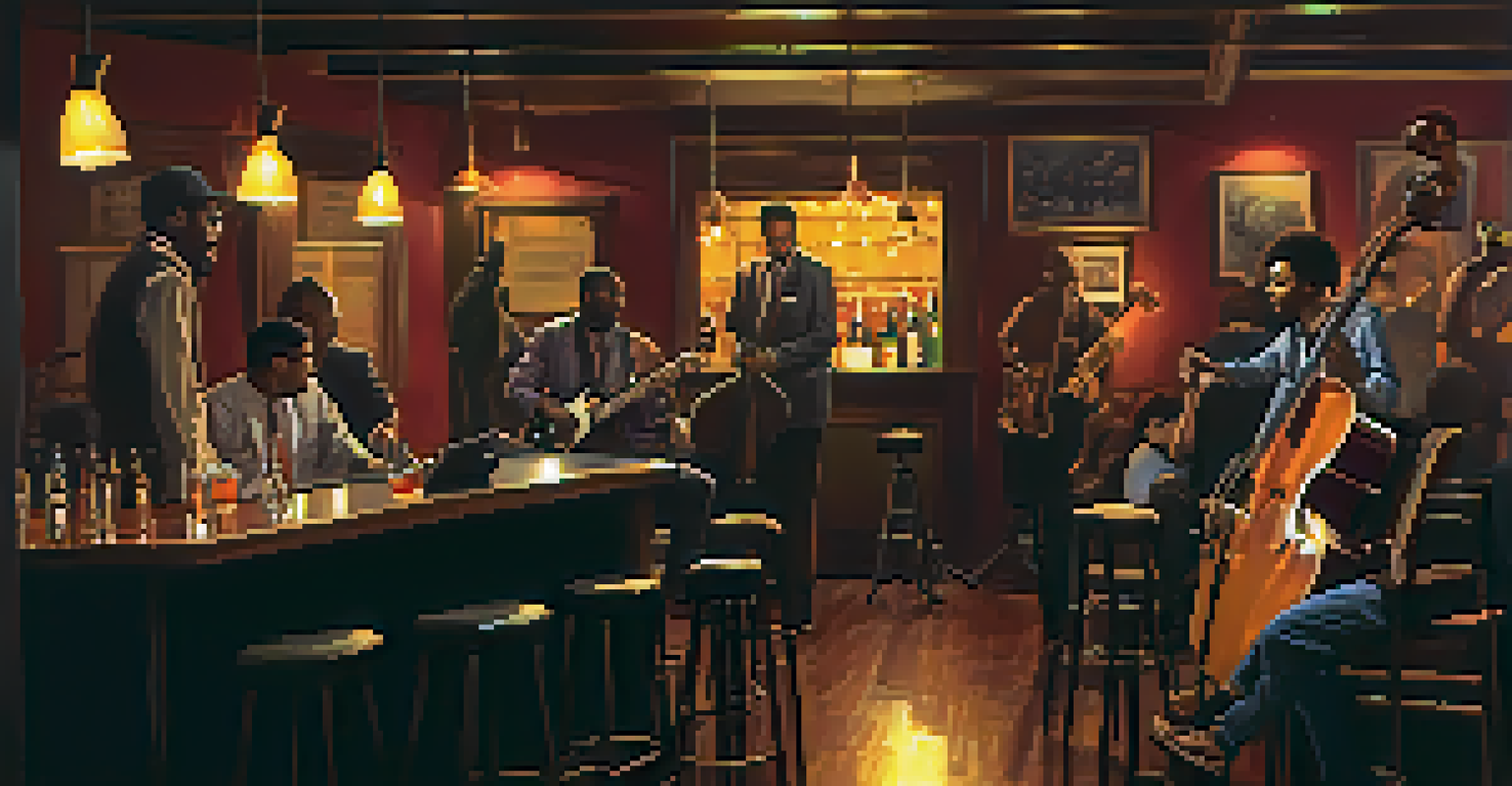Jazz Bands and Guitars: The Art of Chord Progressions

The Heart of Jazz: Understanding Chord Progressions
Chord progressions are the backbone of any musical genre, and jazz is no exception. They provide the harmonic framework that supports melodies and improvisations, allowing musicians to express their creativity. In jazz, these progressions can be intricate and varied, often deviating from traditional patterns, which adds to the genre's unique sound.
Jazz is not just music, it's a way of life, a way of being, a way of thinking.
For instance, a common jazz progression is the ii-V-I, which creates a sense of movement and resolution. Musicians can experiment with different voicings and extensions to make these chords richer and more complex. This flexibility is what makes jazz so exciting and unpredictable, inviting musicians to explore new musical territories.
As we delve deeper into the role of guitars in jazz bands, it's important to recognize how they complement these progressions. Guitars can provide rhythm, harmony, and even melody, making them integral to the jazz ensemble's sound.
The Role of Guitars in Jazz Bands
In a jazz band, the guitar often serves as both a rhythm and lead instrument. While the rhythm section lays down the foundation with bass and drums, the guitarist can weave in chords and solos that enhance the overall sound. This dual role allows guitarists to showcase their technical skills and creativity throughout a performance.

Take, for example, the great Wes Montgomery, who revolutionized the use of guitar in jazz. He combined chord melodies with unique picking techniques, which captivated audiences and inspired countless musicians. His approach exemplifies how the guitar can be used to push the boundaries of traditional jazz sounds.
Jazz Chord Progressions Explained
Chord progressions form the essential framework for jazz, allowing musicians to express creativity through intricate and varied harmonic structures.
Moreover, the guitar's versatility means that it can adapt to various styles within jazz, whether it's bebop, cool jazz, or fusion. This adaptability is key to its enduring presence in jazz bands, allowing musicians to explore a wide range of expressions and emotions.
Chord Extensions: Adding Depth to Progressions
One of the hallmarks of jazz is its use of chord extensions, which add richness and complexity to chord progressions. These extensions, such as 7ths, 9ths, and 13ths, can transform a simple triad into a lush, expressive harmony. This practice not only enhances the musical texture but also provides greater room for improvisation.
The beautiful thing about learning is that no one can take it away from you.
For example, a C major chord can be extended to Cmaj7 by adding a B note. This subtle change can completely alter the chord's character, giving it a jazzier feel. Guitarists often utilize these extensions in their playing, showcasing their understanding of harmony and enhancing their improvisational skills.
By incorporating these extended chords, jazz bands can create a more engaging and colorful sound. This depth is essential for captivating audiences and inviting them into the musicians' creative journey.
Improvisation: The Jazz Guitarist's Playground
Improvisation is a cornerstone of jazz music, and the guitar plays a pivotal role in this spontaneous artistry. Guitarists often take turns soloing over established chord progressions, allowing them to express their individuality and creativity in real time. This is where jazz truly comes alive, as each musician adds their unique voice to the performance.
Consider how a guitarist might interpret a classic standard like 'Autumn Leaves.' While the chord progression remains the same, each player's solo can vary dramatically, showcasing different techniques, scales, and emotions. This diversity is what makes live jazz performances so thrilling and unpredictable.
Guitars Shape Jazz Sound
In jazz bands, guitars play a dual role as both rhythm and lead instruments, enhancing the overall sound with technical skills and creative improvisation.
Moreover, improvisation encourages musicians to listen closely to one another, fostering a sense of camaraderie and collaboration within the band. This interactive dynamic is what sets jazz apart from many other genres, making it a deeply enriching experience for both performers and listeners.
The Influence of Jazz on Modern Guitar Playing
Jazz has had a profound impact on contemporary guitar playing, shaping the techniques and styles of countless musicians across genres. From rock and blues to pop and country, the influence of jazz can be heard in various forms of music today. Guitarists often incorporate jazz chords and progressions into their playing, enriching their sound and expanding their musical vocabulary.
For instance, artists like John Mayer and Eric Clapton often draw inspiration from jazz guitarists, infusing their songs with complex harmonies and subtle improvisational elements. By blending jazz techniques with their own unique styles, they create music that resonates with a broad audience while paying homage to the genre's rich history.
This cross-pollination of styles highlights the versatility of the guitar and the enduring legacy of jazz. As musicians continue to experiment and innovate, the influence of jazz will undoubtedly inspire future generations of guitarists.
Learning Jazz Guitar: Tips and Techniques
For those interested in learning jazz guitar, there are several techniques and tips that can help you navigate the complexities of the genre. Start by familiarizing yourself with essential jazz chords and progressions, as these will form the foundation of your playing. Practice transitioning between chords smoothly, as fluidity is crucial in jazz improvisation.
Additionally, listening to great jazz guitarists can provide invaluable insights into phrasing, tone, and style. Pay attention to how they utilize chord extensions and improvisational techniques, and try to incorporate these elements into your own playing. Transcribing solos from your favorite jazz guitarists can also deepen your understanding of their approach and inspire your own creativity.
Improvisation Drives Jazz
Improvisation is a fundamental aspect of jazz, enabling guitarists to showcase their individuality while fostering collaboration within the ensemble.
Lastly, don't forget the importance of practice and patience. Jazz is a genre that rewards dedication, so be sure to spend time honing your skills and exploring different styles within the genre. With persistence and passion, you'll find your voice as a jazz guitarist.
The Future of Jazz Guitar and Chord Progressions
As we look to the future, the evolution of jazz guitar and chord progressions continues to unfold. New generations of musicians are embracing the genre while blending it with various influences, resulting in innovative sounds that challenge traditional boundaries. This creative fusion ensures that jazz remains a dynamic and relevant force in the music world.
Moreover, advancements in technology have opened up new avenues for exploration. With tools like loop pedals and digital effects, guitarists can experiment with layering sounds and creating complex textures that were once difficult to achieve. This technological integration allows for even more creativity and expression within the jazz genre.

Ultimately, the future of jazz guitar lies in its adaptability and the willingness of musicians to push the envelope. As artists continue to explore and innovate, the legacy of jazz will thrive, inspiring new listeners and performers alike.